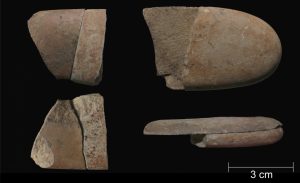Study of marine pebble tools from an Upper Palaeolithic burial site Caverna delle Arene Candide in Liguaria, Italy, suggests that objects might have been ritually destroyed to remove their symbolic power some 5000 years earlier than previously thought.

The site is a cave, located nearly 90 metres above the sea in a steep cliff, containing burials of about 20 adults and children. Researchers examined 29 pebble fragments and concluded that about 12000 years ago the flat, oblong pebbles were brought up from the beach, used as spatulas to apply ochre paste to decorate the dead, then broken and discarded. Archaeologists believe that this final action was possibly meant to destroy the objects, which had come into contact with the deceased, in order to discharge them of their symbolic power.

The researchers carried out microscopic analysis of the pebbles they found in the cave, and also scoured nearby beaches in search of similar-looking pebbles, broke them to see if they compared to the others, trying to determine whether they had been deliberately broken. According to archaeologists the find is the earliest evidence of intentional fragmentation of objects in a ritual context. The next oldest evidence dates to the Neolithic period in Central Europe, about 8000 years ago. Objects from Caverna delle Arene Candide date to somewhere between 11000-13000 years ago, when people in Liguria were still hunter-gatherers.

The findings could have implications for research at other Palaeolithic sites where ochre-painted pebbles have been found, such as the Azilian sites in the Pyrenee mountains of northern Spain and southern France. According to the researchers, broken pebbles recovered during excavations often go unexamined, so going back and taking a second look might result in new discoveries.
(after International Business Times, Past Horizons & Université de Montréal)